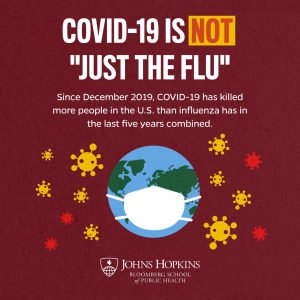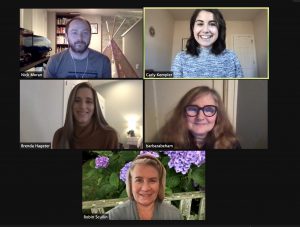PRSA presented its 2021 PR Professional of the Year Award to the Audience Reach and Engagement Team in the Office of External Affairs at the Johns Hopkins Bloomberg School of Public Health for its efforts to help elevate the institution’s important work surrounding the global COVID-19 pandemic. The Bloomberg School of Public Health is part of Johns Hopkins University in Baltimore.
The team’s activities included sharing the school’s scientific and policy expertise with a world eager to understand a new virus, how it spreads and the uncertain effects.
The five-member team accepted the award during PRSA’s virtual Silver Anvil Ceremony on June 10, including: Robin Scullin, director, audience and stakeholder engagement; Barbara Benham, associate director, media and public relations; Nick Moran, associate director, audience development; Brenda Hageter, social media specialist; and Carly Kempler, audience reach and engagement specialist.
Here, the team collectively answered questions about their strategic internal and external outreach, which reached and engaged new audiences during the tragedy of a global pandemic and helped the Bloomberg School retain its No. 1 ranking in the latest U.S. News & World Report rankings for U.S. schools of public health.
On social media, what creative tactics did the team use to tap the faculty’s expertise?
During the pandemic, we used several tactics on social media to ensure our information was easy to understand for the general public. First, we developed a Twitter list of our faculty with expertise related to the coronavirus and the epidemiology of pandemics. We regularly used this resource to monitor their takes on certain topics (what’s [going on] with testing, what’s the next challenge in the United States or abroad, what are experts saying about the vaccine timeline, etc.). Even today, this remains a valuable resource for us.
Second, we used illustrations and animation to supplement their explanations (as shown in this video). This tactic served to simplify complex ideas and keep viewers engaged. Third, we often posed real-world scenarios to our faculty and had them talk through precautions for everyday activities that our audience members might be considering (such as travel). Fourth and perhaps most frequently, we worked with communications colleagues around the school as well as trusted doctoral candidates to help our social team quickly secure technical reviews/accuracy checks on our social media content.
By engaging these stakeholders and student experts to vet our content, we spared our busy faculty from the behind-the-scenes but very important work of ensuring our content was accurate; this freed our faculty up for more on-camera or front-and-center availability.
Amid so many stats and reports related to the pandemic, some news consumers are experiencing information fatigue. How were you able to present this information to audiences without overwhelming them with numbers?
When it comes to presenting data, it is important to include the statistics that get particular messages across. It is also important to note that not all messages need to be presented with statistics. For the Johns Hopkins Bloomberg School of Public Health’s social media team, it was important to get messages across in ways that our general audiences could intuitively understand.
Instead of saying “wearing a mask reduces transmission risk by x%” in a social media message, we might say “avoid sharing the same air as other people, especially indoors” because that’s easier for people to internalize. In our social posts, we’d then link to a webpage where users could see the data behind our messages — like “show your work” exercises in school.
As a team, we worked together to create information for the public in ways that would catch their attention without distracting them with numbers. In this video on mRNA vaccines, we included the most important information that our audiences would want to know and presented it in a way that people would be able to understand, without throwing a bunch of data or jargon into the mix.
Another way we presented the information was through our daily podcast. In each episode, guests were able to present information as part of a conversation so that people could understand the issue’s importance. In this episode, they discuss gun violence, but you’ll note they only share a couple of statistics. They spend more time talking through real-life examples within communities to help people understand the true impact of the gun-violence crisis.
Through our social media channels, we always aim to promote our content in a way that anyone — especially those without scientific training — could understand.
How did you manage the barrage of media requests, which topped 40 per day? What are some best practices for other communicators?
During the height of the pandemic, we received an unprecedented number of incoming media requests for interviews with our experts from top media outlets including The New York Times, The Wall Street Journal, The Washington Post, The Baltimore Sun, BBC, CNN, C-SPAN, NPR, ABC News, NBC News, CBS Evening News, Fox News and others.
Handling all of these incoming requests was challenging, especially as most of our leading experts have many other demands on their time, including lab work and research. To respond to these requests efficiently, we developed a system to track journalist requests, identifying their name, outlet, subject matter and current status or deadline. We updated and monitored this grid regularly, ensuring that we followed up on requests in a timely fashion to connect our experts with inquisitive reporters.
We also used this tracking system to expand our list of media contacts. Developing a COVID-19 media list, we invited all reporters to our COVID-19-related events, such as our expert media briefings, school webinars and symposia.
This list has become an invaluable resource especially as so many reporters were transferred to the health/science beat so suddenly. Before the pandemic, many of these journalists mainly reported on lifestyle, breaking news, theater and travel, and had to quickly shift gears to build contacts and report on the surging virus.
How else did the team meet the growing media demand?
In an effort to streamline these requests and make the most of our experts’ time, we developed monthly topic-specific Expert Media Briefings featuring two of our expert faculty members. We worked with our PR firm (Burness) to ensure that these pressers provided the most up-to-date and newsworthy information related to the COVID-19 pandemic to avoid additional one-on-one interviews with faculty experts.
How did you address any misinformation or disinformation that you saw in news reports or on social media?
Our social media team addresses mis/disinformation in two ways: responsive debunking or proactive “pre-bunking.” In the first case, one of our best tactics was to compile commonly asked questions or comments we received about various aspects of COVID-19 — how it spreads, vaccine efficacy, etc. — and allow our doctoral students to respond to them directly in engaging, friendly, approachable videos. (You can find an example here.)
This strategy allowed our doctoral students at the school — who work closely with their faculty advisers — to address common concerns in easy-to-understand, gentle ways. In the case of “pre-bunking,” our social media team worked with faculty to generate quick responses to misconceptions we knew were arising, or to erroneous talking points we knew were going to start trending. And then we developed content to address those issues head-on before they got a chance to take hold. A great example of this was our “COVID is Not the Flu” infographics, which reached over 20 million users on Facebook alone.

Given the constantly evolving news cycle, what were the challenges of measuring the results of your efforts in real-time?
We tracked our results in real-time, utilizing our school’s “In the News report,” a daily compendium of our media placements with links. This reporting method was in place well before the start of the pandemic and it became a vital tool to measure, track and share our school’s media mentions and feature stories in the ever-evolving news cycle.
For “In the News,” we draw from a daily monitoring report from Cision and targeted Google searches to manually compile a list of the expert’s (and school’s) media mentions. Each entry includes the story’s name, hyperlink, a brief summary and which expert, report or center is featured. During the height of the pandemic, this daily report often had at least 25–40 entries, consisting of print, online and broadcast mentions. The report also tracks opinion editorials published by our faculty and students.
During this time, you focused not just on the pandemic, but also on other important subjects, such as racial health disparities and adult hearing loss. How did you prioritize the school’s expert voices and content?
We recognize that our experts’ work covers an amalgam of topics and the pandemic did not stop the important research that many of them were/are conducting.
For example, in June 2020, we published a news release about a study on the linkage of hospital and other records predicting both fatal and nonfatal opioid overdoses. In January 2020, we published a news release on FDA documents revealing inadequate monitoring of a key program to promote safe opioid use. In 2021, our experts, with the University of California, San Francisco, released a digital trove of opioid-industry documents, which received widespread media attention, even in the midst of the pandemic.
The pandemic also offered a platform to highlight and address racial health disparities and mental health. We worked with researchers to pinpoint direct ties to their expertise and the current news cycle, as COVID-19 impacted many minorities who do not have access to basic health care.
Were you and your team able to achieve a work-life balance during the pandemic?
It was challenging to maintain a work-life balance as we addressed growing communications needs in a timely fashion. We did so by establishing boundaries to have some personal time in the evening or at lunch to ensure that everyone’s workload was manageable and that we had “stretch” and Zoom breaks.
We also worked seamlessly as a team to handle the rush of requests, helping one another with tasks, and tagging and tapping each other when needed. During our bi-monthly, virtual team meetings, we always make time to socialize and to keep things light in addition to discussing our current projects and other work-related topics. When weekend media inquiries were at their peak, we created a schedule with our team members so we could each get at least one day’s break from [our computer] devices.
Working remotely and sitting through Zooms presented challenges as well. But many of us took up yoga, hiking and stretch breaks as a way to get through the long periods of sitting and Zooming. Additionally, we took advantage of working remotely by taking up new hobbies, such as more cooking, baking bread, taking daily runs during the workday and embroidering.

What impact do you think your work has had on the global reputation of Johns Hopkins?
As the No. 1 ranked school of public health for 27 years in a row, the Bloomberg School has had a long-standing reputation for being a trustworthy and dependable source for public-health information and guidance. The COVID-19 pandemic [brought attention to] public health and the work being done at our school (and so many others) and we were there to help shine a light on our much-needed experts.
Though we’ve had longstanding connections with national and global media outlets, our close work with these journalists over the last year or more of the pandemic has certainly strengthened these ties. Reporters return our calls — and fast.
The Bloomberg School has been cited and quoted in countless publications over the course of the pandemic and has become a household name to get the most up-to-date and reliable information on the pandemic. We are confident this trend will continue for years to come.
John Elsasser is PRSA’s publications director and editor-in-chief of its award-winning publication, Strategies & Tactics. He joined PRSA in 1994.

